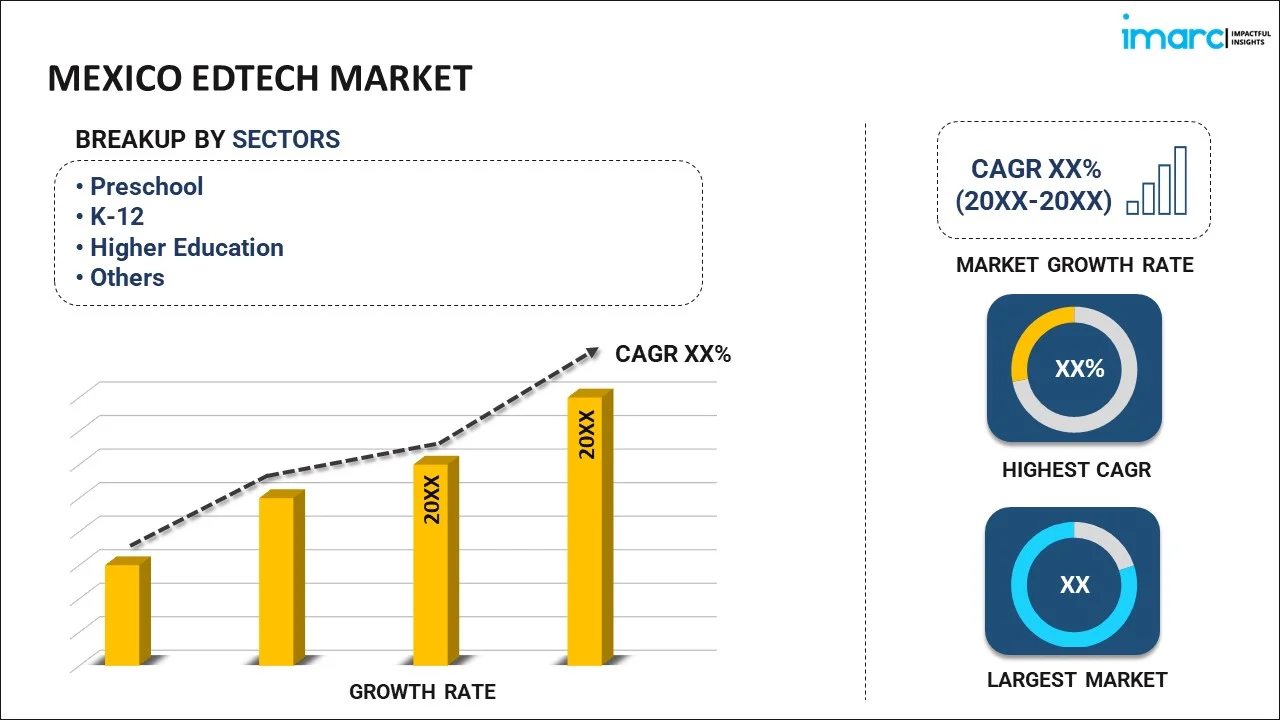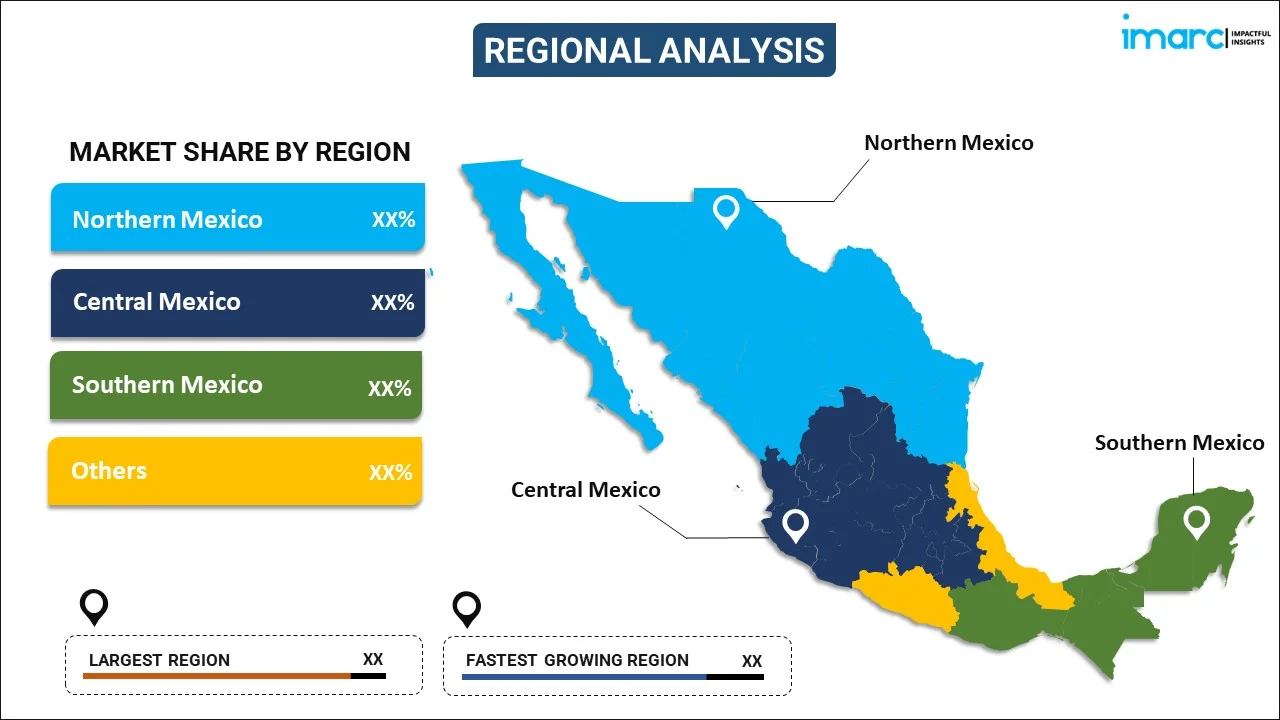
Mexico Edtech Market Report by Sector (Preschool, K-12, Higher Education, and Others), Type (Hardware, Software, Content), Deployment Mode (Cloud-based, On-premises), End User (Individual Learners, Institutes, Enterprises), and Region 2025-2033
Mexico Edtech Market Size, Share & Analysis:
Mexico edtech market size reached USD 4.4 Billion in 2024. Looking forward, IMARC Group expects the market to reach USD 14.4 Billion by 2033, exhibiting a growth rate (CAGR) of 12.80% during 2025-2033. The shifting consumer preferences towards online learning programs, owing to their flexibility and real-time feedback, are primarily driving the market growth across the country.
|
Report Attribute
|
Key Statistics
|
|---|---|
|
Base Year
|
2024 |
|
Forecast Years
|
2025-2033
|
|
Historical Years
|
2019-2024
|
| Market Size in 2024 | USD 4.4 Billion |
| Market Forecast in 2033 | USD 14.4 Billion |
| Market Growth Rate (2025-2033) | 12.80% |
Mexico Edtech Market Insights:
- Key Market Drivers: Increasing internet penetration, accelerating mobile phone usage, and amplifying need for flexible and inclusive learning solutions are key drivers driving Mexico edtech market demand. Government education efforts through online channels and a young, technologically savvy population further drive sector growth in educational as well as professional settings.
- Main Market Trends: Hybrid models of learning, artificial intelligence (AI) driven learning solutions, and competency-based platforms are emerging in Mexico's edtech space. Focus is turning from conventional degrees to competency-based learning with digital platforms incorporating adaptive diagnostics, game-based material, and micro-credentialing to enhance learner experience and results.
- Competitive Landscape: Mexico's education technology environment encompasses varied players, ranging from homegrown startups to international platforms with language training, K-12 solutions, and vocational courses. Market rivalry increases around personalization, multilingual materials, price points, and alignment with national curricula, as companies aim to boost digital learning reach and stickiness.
- Challenges and Opportunities: Inequitable access to digital infrastructure has been a persistent barrier in underserved regions and rural areas. But the expanding coverage of 5G, public-private partnerships, and the rise of mobile-first edtech solutions present the opportunity to bridge learning gaps and expand digital learning equity across Mexico.
Edtech, commonly known as education technology, provides education through online means. It comprises both hardware and software aimed at delivering virtual education to enhance learning experiences of students and improve educational outcomes. Employing technology in the teaching and learning process helps students overcome barriers to acquiring a well-rounded education. The creation of digital content is more cost-effective than traditional printed materials, leading to the growing popularity of e-books among learners due to their affordability, adaptability, portability, etc. Furthermore, individuals with disabilities can derive advantages from audio formats of educational content, aiding in vocabulary enhancement and fostering interpretive reading skills. In essence, edtech plays a pivotal role in transforming and optimizing the educational landscape by leveraging advanced technologies to make learning more accessible, cost-effective, and tailored to diverse learning needs.
Mexico Edtech Market Trends:
Growing Integration of AI-Driven Learning Platforms
The Mexico edtech industry is seeing significant change with the growing use of artificial intelligence-based learning platforms. These AI platforms are developed to provide personalized content and adaptive measures that converge according to individual learning demands, particularly in K-12 and post-secondary education. Teachers gain from real-time analytics enabling them to keep track of performance and adjust instructional approaches accordingly. This data-fueled method is also being combined with current curriculums to increase student engagement, enhance student retention, and accommodate differentiated instruction. The national education system's shift toward more scalable and personalized teaching approaches is reflected in increased spending on AI-powered classroom technologies. Furthermore, the level of innovation is also consistent with competency-based learning models becoming popular in the nation. While stakeholders focus on digital evolution, AI adoption continues to be a core part of Mexico edtech market growth, facilitating systemic upgrading. Such AI learning platforms are likely to become further entrenched as core building blocks of Mexico's digital learning ecosystem.
Growth of Hybrid Learning Ecosystems
Hybrid models of learning are coming to dominate Mexico edtech as they integrate classroom teaching with online learning tools. This hybrid method allows synchronous in-class courses in conjunction with asynchronous online modules, expanding access and flexibility in student populations. As internet infrastructure and device access continue to improve, schools at the primary through tertiary levels are embracing hybrid models to allow remote and in-class learning. These platforms accommodate multimedia material, virtual collaboration tools, and personalized assignments accessible across devices. The appeal of hybrid learning is supported by its potential to provide ongoing learning despite geographic or socioeconomic limitations. Corporate upskilling initiatives and vocational training facilities are also embracing hybrid models to accommodate changing learner demands. The transition underscores the resilience and long-term applicability of digital learning in Mexico's educational landscape. This mass adoption is a reflection of the larger shift documented in Mexico edtech market analysis, underlining inclusive, scalable, and sustainable learning models.
Increase in Demand for Skill Development and Language Learning Solutions
Edtech in Mexico is highly concerned with the delivery of career-specific skill development and language learning solutions. A major segment of the population—particularly students and working professionals—is looking for online courses that provide training in digital competencies, business communication, and language skills, especially English. These sites typically incorporate interactive content, game elements, and micro-credentials that resonate with younger learners. The trend mirrors growing interest in industry-relevant competencies across areas of information technology, customer service, and finance. Mobile-first apps enable these learning products to be accessed even in less-connected areas, and flexible modules allow for self-paced learning. Such program growth is complemented by the nation's conformity with international workforce demands and the need to become more employable. These trends are key to defining Mexico edtech market forecast, showing steady demand for outcomes-based education. As students value skills more than the conventional degree, edtech vendors extend content libraries and testing tools for real-world training.
Mexico Edtech Market Segmentation:
IMARC Group provides an analysis of the key trends in each segment of the market, along with forecasts at the country level for 2025-2033. Our report has categorized the market based on sector, type, deployment mode, and end user.
Sector Insights:

To get more information on this market, Request Sample
- Preschool
- K-12
- Higher Education
- Others
The report has provided a detailed breakup and analysis of the market based on the sector. This includes preschool, k-12, higher education, and others.
Type Insights:
- Hardware
- Software
- Content
A detailed breakup and analysis of the market based on the type have also been provided in the report. This includes hardware, software, and content.
Deployment Mode Insights:
- Cloud-based
- On-premises
The report has provided a detailed breakup and analysis of the market based on the deployment mode. This includes cloud-based and on-premises.
End User Insights:
- Individual Learners
- Institutes
- Enterprises
A detailed breakup and analysis of the market based on the end user have also been provided in the report. This includes individual learners, institutes, and enterprises.
Regional Insights:

- Northern Mexico
- Central Mexico
- Southern Mexico
- Others
The report has also provided a comprehensive analysis of all the major regional markets, which include Northern Mexico, Central Mexico, Southern Mexico, and Others.
Competitive Landscape:
The market research report has also provided a comprehensive analysis of the competitive landscape in the market. Competitive analysis such as market structure, key player positioning, top winning strategies, competitive dashboard, and company evaluation quadrant has been covered in the report. Also, detailed profiles of all major companies have been provided.
Latest News and Developments:
- In May 2025, Ignite Copilot, an edtech startup based in Spain, opened a €500,000 funding round to grow in Latin America, including Mexico. Having earned a reputation for its AI tools for teachers, the company plans to make strategic partnerships and solidify its hold in Spanish and Latin American education markets until 2026.
- In October 2024, Brazilian edtech Layers Education entered Mexico through a partnership with local firm Lírica. The venture aims to speed up digital transformation at schools with the launch of Layers' education SuperApp, fusing scalable technology with Lírica's local know-how on educational innovation and market building.
Mexico Edtech Market Report Coverage:
| Report Features | Details |
|---|---|
| Base Year of the Analysis | 2024 |
| Historical Period | 2019-2024 |
| Forecast Period | 2025-2033 |
| Units | Billion USD |
| Scope of the Report | Exploration of Historical Trends and Market Outlook, Industry Catalysts and Challenges, Segment-Wise Historical and Future Market Assessment:
|
| Sectors Covered | Preschool, K-12, Higher Education, Others |
| Types Covered | Hardware, Software, Content |
| Deployment Modes Covered | Cloud-based, On-premises |
| End Users Covered | Individual Learners, Institutes, Enterprises |
| Regions Covered | Northern Mexico, Central Mexico, Southern Mexico, Others |
| Customization Scope | 10% Free Customization |
| Post-Sale Analyst Support | 10-12 Weeks |
| Delivery Format | PDF and Excel through Email (We can also provide the editable version of the report in PPT/Word format on special request) |
Key Benefits for Stakeholders:
- IMARC’s industry report offers a comprehensive quantitative analysis of various market segments, historical and current market trends, market forecasts, and dynamics of the Mexico edtech market from 2019-2033.
- The research report provides the latest information on the market drivers, challenges, and opportunities in the Mexico edtech market.
- Porter's five forces analysis assist stakeholders in assessing the impact of new entrants, competitive rivalry, supplier power, buyer power, and the threat of substitution. It helps stakeholders to analyze the level of competition within the Mexico edtech industry and its attractiveness.
- Competitive landscape allows stakeholders to understand their competitive environment and provides an insight into the current positions of key players in the market.
Key Questions Answered in This Report
The edtech market in Mexico was valued at USD 4.4 Billion in 2024.
The Mexico edtech market is projected to exhibit a (CAGR) of 12.80% during 2025-2033, reaching a value of USD 14.4 Billion by 2033.
The market is fueled by growing internet penetration, rising smartphone adoption, and an upsurge in demand for distance and personalized learning opportunities. Digital education support by the government is complemented by the growing necessity for ongoing skill development for all age groups, which further fuels the robust growth of the industry.
Need more help?
- Speak to our experienced analysts for insights on the current market scenarios.
- Include additional segments and countries to customize the report as per your requirement.
- Gain an unparalleled competitive advantage in your domain by understanding how to utilize the report and positively impacting your operations and revenue.
- For further assistance, please connect with our analysts.
 Request Customization
Request Customization
 Speak to an Analyst
Speak to an Analyst
 Request Brochure
Request Brochure
 Inquire Before Buying
Inquire Before Buying




.webp)




.webp)












